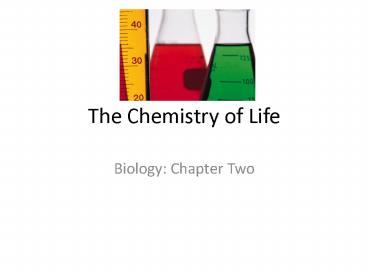The Chemistry of Life - PowerPoint PPT Presentation
1 / 15
Title:
The Chemistry of Life
Description:
The Chemistry of Life Biology: Chapter Two Atoms An atom is the smallest unit of matter that cannot be broken down by chemical means Consists of 3 particles electrons ... – PowerPoint PPT presentation
Number of Views:208
Avg rating:3.0/5.0
Title: The Chemistry of Life
1
The Chemistry of Life
- Biology Chapter Two
2
Atoms
- An atom is the smallest unit of matter that
cannot be broken down by chemical means - Consists of 3 particles
- electrons (- charge)
- Protons ( charge)
- Neutrons (no charge)
3
Elements
- Elements are pure substances made of only one
kind of atom there are over 100 known elements - Elements differ in the number of PROTONS their
atoms contain
4
Isotopes
- Atoms of an element that contain different
numbers of neutrons are called isotopes. - EX isotopes of Carbon carbon-12, carbon-13,
- carbon-14
- Each contain 6 protons but different neutrons
5
Periodic table, pages 1046, 1047
6
Compounds
- A compound is a substance made of the joined
atoms of two or more different elements. - Ex NaCl, sodium chloride
- H2O, water
- NH3, ammonia
7
Covalent Bonds
- Covalent bonds form when two or more atoms share
electrons to form a molecule - Example H2O, water
8
Hydrogen Bonds
- A hydrogen bond is a weak chemical attraction
between polar molecules - Polar molecule a molecule that has opposite
charges (polarity) (/-)
9
Hydrogen Bonding in Water Molecules
10
Ions and Ionic Bonds
- An atom that has gained or lost electrons is
called an ion. - Ions of opposite charge (/-) may interact to
form a ionic bond. - Ex NaCl (sodium chloride)
11
Water and Solutions
- Fun Facts
- Water makes up 70 of your body!
- 2/3 of the molecules in your body are H2O
molecules - Most cellular events take place in H2O
- Water absorbs heat more slowly and retains this
energy longer! (compared to other liquids)
12
- Cohesion attraction between substances of the
SAME kind
13
- Adhesion attraction between DIFFERENT
substances
14
Acids and Bases
- While the bonds in water molecules are strong, at
any given time a tiny fraction of those bonds
might break, forming a hydrogen ion, H, and a
hydroxide ion, OH- - H2O ? H OH-
15
- Acid form hydrogen ions when dissolved in water
- Base form hydroxide ions
- Acidic Neutral Basic































